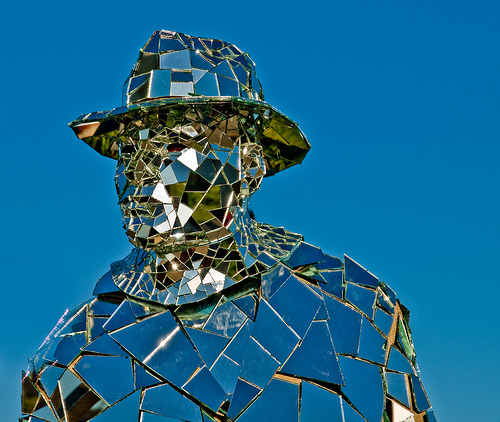Men Wearing Mirrors: Portuguese Conquistador in Northern Australia? December 8, 2013
Author: Beach Combing | in : Modern , trackbackThe Portuguese ‘discovery’ of Australia is one that has excited Australians and Europeans for most of the last century, since, in fact, it was first realized that there was a very real chance that Portuguese ships could very easily have headed south from their base at Timor and have run smack-bang into ‘the lost continent’. Beach was particularly intrigued by a reference in Ian McIntosh’s article on the Wessel Islands to a possible early Portuguese visit. Dr McIntosh writes:
Yolngu [Wessel Islands Aborigines] oral history makes reference to men clothed in ‘mirror’ landing on the coast, a probable reference to armour, which is suggestive of the Portuguese (19).
Beach, as long time readers of this post will attest, is obsessed with oral transmission and by his calculations we are talking of a legend here that, for it to be the Portuguese, must have come down anything from 350 to 250 years in Yolngu tradition. What really are the chances that that could actually have happened? If this were medieval Europe (the reality he knows best) then Beach would be shaking his head in a very definite manner. There is though the example, examined previously in this blog of Arctic oral legends about early European visitors.
The other problem is the idea of men clothed in mirrors. As the Yolngu presumably did not have mirrors when these putative Portuguese arrived how can this be? Is it a question that mirrors were known by the eighteenth century and that they then articulated something from earlier on in Yolngu tradition: for example, ‘their clothes showed our faces’. Not sure how this would work at all. The Portuguese did wear breastplates though in the sixteenth century. If the linguistic problems could be cleared away then this would all become very intriguing.
Ian McIntosh gives another example in his article of oral tradition and memory namely: ‘a site in the English Company’s Islands called Marak which is associated with gunfire, a sure indicator of problematic relations.’ The English company islands are adjacent to the Wessels. Of course, gunfire is much harder to mark down chronologically than men wearing mirrors. It could be a sixteenth-century Portuguese conquistador or it could be a drunk nineteenth-century Australian captain blown off course in a gale, rifle in hand. The problem with these oral legends from pre-literate societies is always the same. It is next to certain that there is treasure: the problem is that the gold and the fools gold are indistinguishable and the lack of documentation mean that there is no way to get at the good stuff.
Other examples of oral transmission over generations: drbeachcombing AT yahoo DOT com
18 Dec 2013: Borky comments on this sentence “The other problem is the idea of men clothed in mirrors…the Yolngu presumably did not have mirror…If the linguistic problems could be cleared away then this would all become very intriguing.” Beach workin’ on the basis most mythologies have myths featurin’ water as the earliest prototypical reflective surfaces I hunted down Bealuah Lowe’s Yolngu dictionary http://www.aurhim.net/test/journal/B.Lowe_Web_Dict.pdf an’ found djarrany’tjun 1) mirror. 2) glass. and djarra rain water (rock pool). Oddly enough given the association with the Wessel coins you’ve been so *hoarse* about [hoarse Wessel!] djarrany’tjun also means dig, scratch the ground Words endin’ ny’tjun [or variants] eg garrany’tjun to paddle (canoe) or !irrany’thun gnaw, bite at. Variant: lirrany’tjun seem t’be verbs. Y’do realise though if the reflectivity o’ water’s the origin o’ the mirror men this strengthens the slight possibility whoever or whatever Oannes was a representative of may’ve been involved in this particular contact. Of course spacemen in tinfoil suits’re awf’ly reflective too… Thanks Borky!
30 Sept 2015: Bruce T writes, This one has stuck with me for a bit. From what I’ve come to understand over the years, European fighting men of the time period cited in the article, late 15th early 16th century preferred to leave their armor as it came straight from the forge, black. It held up to the corrosive elements of both a damp and salty climate better than polished armor. Polished armor was something worn for status back at home and show for aristocratic warriors on the battlefield. Our modern idea of what armor looked like in this era seems to come more from Hollywood than it does sources from the era. A Portuguese sailor in bright shining armor in Australia in the 1520’s? Not unless he stored it in barrel of olive oil and polished it daily on the trip out.
Thanks Bruce!



